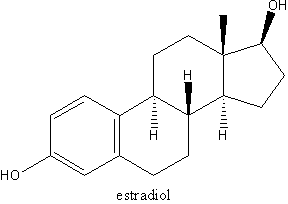Efficacy of Cimicifuga racemosa on climacteric complaints: a randomized study versus low-dose transdermal estradiol. Nappi RE, Malavasi B, Brundu B, Facchinetti F. Gvnecol Endocrinol 2005:20:30-35.
OBJECTIVE: To investigate, in a randomized clinical study, the efficacy of an isopropanolic aqueous extract of Cimicifuga racemosa (CR) on climacteric complaints in comparison with low-dose transdermal estradiol (TTSE2). Hormonal parameters, lipid profile and endometrial thickness were also evaluated. METHODS: Sixty-four postmenopausal women were enrolled and over the course of 3 months filled in a diary recording the number of hot flushes per day. Other climacteric symptoms (vasomotor and urogenital symptoms) as well as anxiety and depression, were evaluated at baseline and after 3 months. Gonadotropins (follicle-stimulating hormone (FSH), luetinizing hormone (LH)), prolactin (PRL), 17 beta-estradiol (17beta-E2) and cortisol, lipid profile (total cholesterol high-density lipoprotein (HDL)/low-density lipoprotein (LDL)-cholesterol, triglycerides, liver function (glutamic-oxalacetic transaminase, glutamic-pyruvic transaminase) and endometrial thickness were measured. Patients were randomly allocated to receive, for 3 months, either 40 mg isopropanolic aqueous CR extract daily or 25 microg TTSE2 every 7 days plus dihydrogesterone 10 mg/day for the last 12 days of the 3-month estradiol treatment. RESULTS: Both CR and low-dose TTSE2 significantly reduced the number of hot flushes per day (p < 0.001) and vasomotor symptoms (p < 0.001), starting at the first month of treatment. Such a positive effect was maintained throughout the 3 months of observation, without any significant difference between the two treatments. An identical effect was evident also for both anxiety (p < 0.001 ) and depression (p < 0.001 ) which were significantly reduced following 3 months of both CR and low-dose TTSE2. Total cholesterol was unchanged by CR treatment but significantly (p < 0.033) reduced by 3 months of low-dose TTSE2. A slight but significant increase of HDL-cholesterol (p < 0.04) was found only in women treated with CR, while LDL-cholesterol levels were significantly lowered by 3 months of both CR (p < 0.003) and low dose TTSE2 (p < 0.002). Triglycerides were not affected by both treatments, nor was liver function. FSH, LH and cortisol were not significantly affected after the 3-month treatment, while PRL (p < 0.005) and 17 beta-E2 (p < 0.001) were increased slightly only by low-dose TTSE2. Endometrial thickness was not affected by either CR or low-dose TTSE2. CONCLUSIONS: CR (40 mg/day) may be a valid alternative to low-dose TTSE2 in the management of climacteric complaints in those women who cannot be treated with or just refuse conventional strategies.
COPYRIGHT 2005 Thorne Research Inc.
COPYRIGHT 2005 Gale Group



